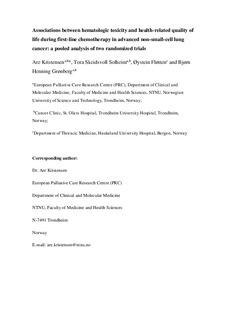| dc.contributor.author | Kristensen, Are Korsnes | |
| dc.contributor.author | Solheim, Tora Skeidsvoll | |
| dc.contributor.author | Fløtten, Øystein | |
| dc.contributor.author | Grønberg, Bjørn Henning | |
| dc.date.accessioned | 2019-04-05T10:44:45Z | |
| dc.date.available | 2019-04-05T10:44:45Z | |
| dc.date.created | 2018-10-11T12:18:44Z | |
| dc.date.issued | 2018 | |
| dc.identifier.citation | Acta Oncologica. 2018, 1-7. | nb_NO |
| dc.identifier.issn | 0284-186X | |
| dc.identifier.uri | http://hdl.handle.net/11250/2593476 | |
| dc.description.abstract | Background: Many patients experience toxicity from chemotherapy that may negatively impact their health-related quality of life (HRQoL), but side effects often go undetected by health care personnel. Our aim was to investigate whether hematologic toxicity (HT) was associated with HRQoL impairment, and, consequently, if blood counts could be used to identify patients with the highest need for supportive care during chemotherapy.
Material and methods: Data from two phase III trials of first-line chemotherapy in advanced non-small-cell lung cancer (NSCLC) were analyzed (n = 873). Blood counts were measured weekly in the treatment period. We categorized patients as having severe (CTCAE grade 3–4) or non-severe (grade 0–2) HT during the first chemotherapy cycle. HRQoL was reported on the EORTC QLQ-C30 and LC13 before and at the end of the cycle. The primary endpoints were changes in global quality of life, fatigue, nausea/vomiting and dyspnea (LC13).
Results: Of the 766 patients with complete data set, 177 (23%) developed severe HT during the first chemotherapy cycle. Changes in fatigue and nausea/vomiting were significantly worse for patients experiencing severe compared to patients with non-severe HT (difference in mean change of 4.9 points; p = .01, and 6.4 points; p = .01, respectively), but this association was limited to neutropenia, not thrombocytopenia or anemia. There were no significant associations between HT and global quality of life or dyspnea (difference in mean change of 2.1 points; p = .28, and 3.3 points; p = .053, respectively).
Conclusions: Patients developing severe HT had worse changes in two out of four of the primary HRQoL endpoints, but the association was not strong enough to use blood counts to identify patients who need more clinical attention and supportive care during chemotherapy. | nb_NO |
| dc.language.iso | eng | nb_NO |
| dc.publisher | Taylor & Francis | nb_NO |
| dc.title | Associations between hematologic toxicity and health-related quality of life during first-line chemotherapy in advanced non-small-cell lung cancer: a pooled analysis of two randomized trials | nb_NO |
| dc.type | Journal article | nb_NO |
| dc.type | Peer reviewed | nb_NO |
| dc.description.version | acceptedVersion | nb_NO |
| dc.source.pagenumber | 1-7 | nb_NO |
| dc.source.journal | Acta Oncologica | nb_NO |
| dc.identifier.doi | 10.1080/0284186X.2018.1492151 | |
| dc.identifier.cristin | 1619633 | |
| dc.description.localcode | Locked until 3.8.2019 due to copyright restrictions. This is an [Accepted Manuscript] of an article published by Taylor & Francis in [Acta Oncologica] on [03 Aug 2018], available at https://doi.org/10.1080/0284186X.2018.1492151 | nb_NO |
| cristin.unitcode | 194,65,15,0 | |
| cristin.unitname | Institutt for klinisk og molekylær medisin | |
| cristin.ispublished | true | |
| cristin.fulltext | postprint | |
| cristin.qualitycode | 1 | |
